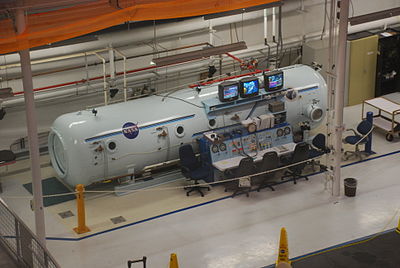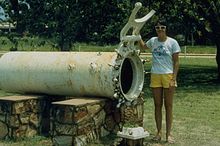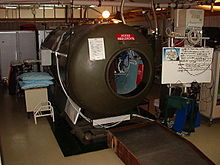- Diving chamber
-
A diving chamber has two main functions:
- as a simpler form of submersible vessel to take divers underwater and to provide a temporary base and retrieval system in the depths;
- as a land or ship-based hyperbaric chamber to artificially reproduce the hyperbaric conditions under the sea (pressures above normal atmospheric pressure) for diving-related and non-diving medical applications such as hyperbaric medicine).
Contents
Basic types of diving chamber
There are two basic types of submersible diving chamber differentiated by the way in which the pressure in the diving chamber is produced and controlled.
Open diving bell
Main article: Diving bellThe historically older open diving chamber, open diving bell or wet bell is in effect a large diving bell, utilising an open bottom, the equivalent of a moon pool, to equalise internal air pressure and external water pressure automatically without the need, necessarily, to measure and control it. An air compressor or bottled compressed air is required to maintain the volume of the air as it becomes compressed with increasing depth, or to make up for oxygen depleted by the occupants' breathing and for carbon dioxide removed from exhaled air by a carbon dioxide scrubber system. This type of diving chamber can only be used underwater, as the internal air pressure is directly proportional to the depth underwater and raising or lowering the chamber is the only way to adjust the pressure.
Hyperbaric chamber
A sealable diving chamber, closed bell or dry bell is a pressure vessel with hatches large enough for people to enter and exit, and an compressed breathing gas supply to raise the internal air pressure. This type is called a hyperbaric chamber whether used underwater or at the water surface or on land to produce underwater pressures, though some use submersible chamber to mean those used underwater and hyperbaric chamber to mean those used out of water. There are two related terms which reflect particular usages rather than technically-different types:
- Decompression chamber, a hyperbaric chamber used by surface-supplied divers to make their surface decompression stops
- Recompression chamber, a hyperbaric chamber used to treat or prevent decompression sickness.
When used underwater there are two ways to prevent water flooding in when the submersible hyperbaric chamber's hatch is opened. The hatch could open into a moon pool chamber, and then its internal pressure must first be equalised to that of the moon pool chamber. More commonly the hatch opens into an underwater airlock, in which case the main chamber's pressure can stay constant, while it is the airlock pressure which shifts. This common design is called a lock-out chamber, and is used in submarines, submersibles, and underwater habitats as well as diving chambers.
Another arrangement utilises a dry airlock between a sealable hyperbaric compartment and an open diving bell compartment (so that effectively the whole structure is a mixture of the two types of diving chamber).
When used underwater all types of diving chamber are attached to a diving support vessel by a strong cable for raising and lowering and an umbilical cable delivering compressed air, power, and communications, and all need weights attached or built in to overcome their buoyancy. The greatest depth reached using a cable-suspended chamber is about 1500 m; beyond this the cable becomes unmanageable.
Related equipment
In addition to the diving bell and hyperbaric chamber, related diving equipment includes the following.
- Underwater habitat: consists of compartments operating under the same principles as diving bells and diving chambers, but fixed to the sea floor for long-term use.
- Submersibles and submarines differ in being able to move under their own power. The interiors are usually maintained at surface pressure, but some examples include air locks and internal hyperbaric chambers.
- There is also other deep diving equipment which has atmospheric internal pressure, including:
-
- Bathysphere: name given to an experimental deep-sea diving chamber of the 1920s and 1930s.
- Benthoscope: a successor to the bathysphere built to go to greater depths.
- Bathyscaphe: a self-propelled submersible vessel able to adjust its own buoyancy for exploring extreme depths.
Diving chambers in use underwater
As well as transporting divers, a diving chamber carries tools and equipment, breathing gas cylinders to replenish[citation needed] scuba tanks, and communications and emergency equipment. It provides a temporary dry air environment during extended dives for rest, eating meals, carrying out tasks which can't be done underwater, and for emergencies. Diving chambers also act as an underwater base for surface supplied diving operations, with the divers' umbilicals (air supply, etc) attached to the diving chamber rather than to the diving support vessel.
Use of open diving bell type
Diving bells and open diving chambers of the same principle were more common in the past owing to their simplicity, since they do not necessarily need to monitor, control and mechanically adjust the internal pressure. Secondly since internal air pressure and external water pressure on the bell wall are almost balanced, the chamber does not have to be as strong as a pressurised diving chamber (dry bell). (Actually if h is the distance between a point on the side of the bell and the air/water interface at the bottom, the air pressure at that point is higher than the water on the other side by a water head pressure equivalent to h, but this is a small and constant amount, and is not a structural problem).
A wet diving bell or open diving chamber must be raised slowly to the surface with decompression stops appropriate to the dive profile so that the occupants can avoid decompression sickness. This may take hours, and so limits its use.
Use of hyperbaric chambers
Submersible hyperbaric chambers can be brought to the surface without delay to allow divers to decompress since they can maintain the same pressure at which the divers were working. The divers can stay in the chamber on the support vessel to decompress. This flexibility makes them safer to use and more useful in an accident or emergency, including problems affecting the dive support vessel, such as sudden bad weather. They are used to support saturation diving for which the decompression times are very long.
A diving chamber based on a pressure vessel is more expensive to construct since it has to withstand very high pressure differentials. These may be both crushing pressures when the chamber is lowered into the sea and the internal pressure is kept less than ambient water pressure, or it may be an outwards pressure when it is out of the water and its internal pressure is set the same as water pressure at a certain depth.
Hyperbaric chambers also require more sophisticated systems to set and control internal gas pressure. However modern manufacturing techniques and control systems have reduced the cost and this type of diving chamber is now more common than the older dive bell type.
Hyperbaric lifeboats are specialized diving chambers or submersibles able to retrieve divers or occupants of diving chambers or underwater habitats in an emergency and to keep them in the required decompression phase. They have airlocks for underwater entry or to form a watertight seal with hatches on the target structure to effect a dry transfer of personnel. Rescuing occupants of submarines or submersibles with internal air pressure of one atmosphere requires being able to withstand the huge pressure differential to effect a dry transfer, and has the advantage of not requiring decompression measures on returning to the surface.
Diving chambers in use on land
Hyperbaric chambers are also used on land and at the ocean surface
- to treat divers for decompression sickness (recompression chambers)
- to take surface supplied divers who have been brought up from underwater through their decompression stops (decompression chambers)
- to train and test divers to adapt to hyperbaric conditions and decompression routines
- to treat people using raised oxygen pressure in hyperbaric oxygen therapy, HBOT
- in scientific research requiring elevated gas pressures.
Hyperbaric chambers designed only for use out of water do not have to resist inward crushing forces, only outward expansion forces. Those for medical applications typically only operate up to two or three atmospheres, while those for diving applications may have to go to six atmospheres and above.
Lightweight portable hyperbaric chambers which can be lifted by helicopter are used by commercial diving operators and rescue services to carry one or more divers requiring hospitalisation.
Decompression chamber
A decompression chamber is a pressure vessel used in surface supplied diving to allow the divers to complete their decompression stops at the end of a dive on the surface rather than underwater. This eliminates many of the risks of long decompressions underwater, in cold or dangerous conditions.
-
Two United States Navy sailors inside a decompression chamber about to undergo training
History
The decompression chamber was invented in 1916 by the Italian engineer Alberto Gianni.[1][2]
Recompression chamber
A recompression chamber is a pressure vessel used to treat divers suffering from certain diving disorders such as decompression sickness.[3]
Hyperbaric treatment chamber
A hyperbaric oxygen therapy chamber is used in a hospital or sporting context to treat patients whose condition might benefit from hyperbaric oxygen treatment, including divers. Hyperbaric chambers capable of admitting more than one patient (multiplace) and an inside attendant have advantages for the treatment of decompression sickness and are preferred by the U.S. Coast Guard. Divers with serious complications or injuries may be attended to in this manner during recompression. In addition, multiplace chambers are generally capable of greater depth of recompression, should the need arise. For less seriously ill divers, the more common monoplace chamber is often used. A modified treatment regimen is then used.
- Treatment is ordered by the treating physician (medical diving officer), and is usually in accordance with the U.S. Navy Diving Manual (U.S Navy Diving Tables)[4]. Other treatment tables have been developed, including the Catalina Tables, and others, including proprietary tables.
- Test of pressure. If the diagnosis of decompression illness is considered questionable, the diving officer may order a test of pressure. This typically consists of a recompression to 60 feet seawater for up to 20 minutes. If the diver notes significant improvement in symptoms, or the operator can detect changes in the physical examination, a recompression algorithm is followed.
- Representative diving tables:
- U.S. Navy Table 6. This diving table consists of compression to the depth of 60 feet seawater with the patient on oxygen. The diver is later decompressed to 30 feet on oxygen, then slowly pushed to surface pressure. This table typically takes 4 hours 45 minutes. It may be extended further. It is the most common treatment for type 2 decompression illness.
- U.S. Navy Table 5. This diving table is similar to Table 6 above, but is shorter in duration. It may be used in divers with less severe complaints (type 1 decompression illness).
- U.S. Navy Table 9. This diving table consists of compression to 45 feet seawater with the patient on oxygen, with later decompression to surface pressure. This table is often used by monoplace hyperbaric chambers, or as a follow-up treatment in multiplace chambers.
See also
- Hyperbaric medicine
- Byford Dolphin (decompression accident)
- Diving bell
- Moon pool
- Saturation diving
- Surface supplied diving
- Decompression sickness
- Hyperbaric stretcher
External Links
- "Divers Go to Greater Depths With Aid of Chamber" Popular Mechanics, December 1930 first use of diving chamber by British Royal Navy divers -- detail drawings on subject
- Decompression Chamber in detail
References
- ^ Seventy fathom deep - David Scott - Faber & Faber limited London 1931
- ^ The Egypt gold - David Scott - Faber & Faber London 1932
- ^ "NOAA Ocean Explorer: Monitor Expedition 2002: decompression chamber". National Oceanic and Atmospheric Administration. 2002. http://oceanexplorer.noaa.gov/explorations/02monitor/logs/jul24/media/decomp_chamber.html. Retrieved 3 July 2010.
- ^ http://www.supsalv.org/00c3_publications.asp
Respiratory system surgeries and other procedures (ICD-9-CM V3 21-22, 30-34, ICD-10-PCS 0B) Upper RT nose: Rhinoplasty · Septoplasty · Rhinectomy · Rhinomanometry
larynx: Laryngoscopy · Laryngectomy · Laryngotomy (Thyrotomy)Lower RT trachea: Cricothyrotomy · Tracheoesophageal puncture · Tracheotomy
lung: Pneumonectomy · Wedge resection · Lung transplantation · Decortication of lung · Heart-lung transplantChest wall, pleura,
mediastinum, and diaphragmMedical imaging Bronchography · CT pulmonary angiogram · High resolution CT · Spiral CT · Ventilation/perfusion scanCPRs Lung function test Cytology Respiratory therapy/
intubationDiving decompression Diving Equipment Gases Injury Miscellaneous Algorithms - Decompression algorithm
- Bühlmann decompression algorithm
- Reduced gradient bubble model
- Thalmann algorithm
- Varying Permeability Model

This diving-related article is a stub. You can help Wikipedia by expanding it.








